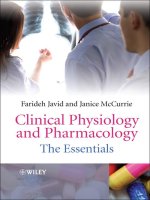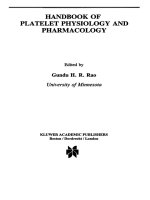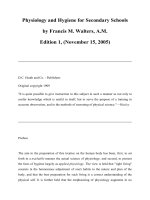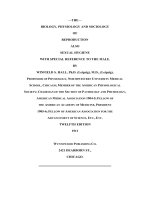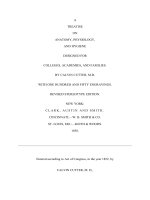PostHarvest Physiology and Preservation ofForages
Bạn đang xem bản rút gọn của tài liệu. Xem và tải ngay bản đầy đủ của tài liệu tại đây (12 MB, 128 trang )
Post-Harvest Physiology and
Preservation of Forages
Related Society Publications
Forage Cell Wall Structure and Digestibility
Forage Quality, Evaluation, and Utilization
For more information on these titles, please contact the SSSA Headquarters Office; Attn: Marketing; 677 South Segoe Road; Madison, WI 53 711-1086. Phone:
(608) 273-8080, ext. 322. Fax: (608) 273-2021.
Post-Harvest Physiology and
Preservation of Forages
Proceedings of a symposium sponsored by C-6 of the Crop Science Society of America. The papers were presented during the annual meetings in
Minneapolis, MN, 1-6 Nov. 1992.
Co-Editors
Kenneth J. Moore
Michael A. Peterson
Managing Editor
David M. Kral
Managing Editor
Marian K. Viney
CSSA Special Publication 22
American Society of Agronomy, Inc.
Crop Science Society of America, Inc.
Madison, Wisconsin, USA
1995
iii
Copyright© 1995 by the American Society of Agronomy, Inc.
Crop Science Society of America, Inc.
Soil Science Society of America, Inc.
ALL RIGHTS RESERVED UNDER THE U.S. COPYRIGHT
ACT OF 1976 (P.L. 94-553)
Any and all uses beyond the limitations of the "fair use" provision
of the law require written permission from the publisher(s) and/or
the author(s); not applicable to contributions prepared by officers or
employees of the U.S. Government as part of their official duties.
American Society of Agronomy, Inc.
Crop Science Society of America, Inc.
Soil Science Society of America, Inc.
677 South Segoe Road, Madison, WI 53711 USA
Library of Congress Cataloging-in-Publication Data
Post-harvest physiology and preservation of forages : proceedings of a
symposium sponsored by C-6 of the Crop Science Society of America
I co-editors, Kenneth J. Moore, Michael A. Peterson ... [et al.].
p. em. - (CSSA special publication : 22)
"The Papers were presented during the annual meetings in Minneapolis, MN, 1-6 Nov. 1992."
Includes bibliographical references.
ISBN 0-89118-539-9
1. Forage plants-Postharvet physiology-Congresses. 2. Forage plants-Postharvest technology-Congresses. I. Moore, Kenneth J. II. Peterson, Michael A. III. Crop Science Society of
America. Division C-6. IV. Series : CSSA special publication : no.
22.
SB188.P7 1995
633.2'086-dc20
95-6087
CIP
Printed in the United States of America
iv
CONTENTS
Page
Foreword......................................................................................................
Preface.........................................................................................................
Contributors .. .. .. ......... .. .. ....... ......... .. ....... ..... .. ..... ......... ..... ....... .. .. .............. ..
vii
ix
xi
1 Post-Harvest Physiological Changes in Forage Plants
Lowell E. Moser............................................................................
1
2 Microbiology of Stored Forages
Craig A. Roberts............................................................................
21
3 Field Curing of Forages
C. Alan Rotz..................................................................................
39
4 Hay Preservation Effects on Yield and Quality
Michael Collins .............................................................................
67
5 Legume and Grass Silage Preservation
E.H. Jaster .....................................................................................
91
v
Foreword
Production and preservation of high quality forages has long been a concern for producers. This publication is jointly sponsored by the Crop Science
Society of America and American Society of Agronomy. It represents the most
current knowledge about preservation of forage crop quality as it is influenced
by post-harvest physiology and microbiology. Producers, agronomists, and crop
scientists will fmd the information in this publication to be beneficial and useful,
particularly as it relates to field curing of forages, and hay and silage preservation.
The co-editors of Post-Harvest Physiology and Preservation of Forages,
K.J. Moore and M.A. Peterson, are well-recognized for their contributions to the
current state ofknowledge in this area of forage research. The authors, M. Collins,
E.H. Jaster, L.E. Moser, C.A. Roberts, and C.A. Rotz are leading scientists and
educators in their respective disciplines. Their background and expertise are wellsuited to integrate the most current knowledge on the complex subject of forage
crop preservation.
This publication will serve as a technical reference for teachers, researchers and producers, who are interested in forage quality and utilization. It will be
helpful in identifying, understanding and managing factors associated with forage crop losses in quality and quantity from the time of harvest through the time
of its use. The technical content of this reference should beneficial for years to
come.
Robert (Bob) C. Shearman
President, CSSA
vii
Preface
The preservation of forage crops is one of the most risk-intensive processes
undertaken by farm managers. From the time that a forage crop is first cut until
it is used as feed, it is subject to significant losses in quality and quantity. These
losses are incurred through a complex set of biotic and abiotic processes that
occur during harvesting and field operations, and later during storage and handling of the product. To minimize the risk associated with forage preservation it
is important to understand these processes, how they interact with one another,
and how their effects can be mitigated through various management practices.
This special publication is based on a symposium of the same title that was
sponsored by the Crop Science Society of America and held during the 1992
annual meeting in Minneapolis, MN. The objective of the symposium was to
integrate knowledge from several disciplines as it relates to the preservation of
forage crops. This publication brings together for the frrst time in one document
the current level of knowledge in this important area. It is intended to be useful
to a broad audience ranging from forage producers to scientists working in the
general area of forage quality and utilization.
The editors wish to express their gratitude to the symposium planning committee who developed the original outline for this publication and to the authors
for their efforts in the preparation of the chapters.
Kenneth J. Moore
Iowa State University, Ames, Iowa
Michael A. Peterson
W-L Research, Inc., Evansville, Wisconsin
ix
CONTRIBUTORS
Michael Collins
Department of Agronomy, University of Kentucky, N-122 Agricultural Science Building-North, Lexington, KY 40546.
Edwin H. Jaster
Department of Dairy Science, California Polytechnic University,
San Luis Obispo, CA 94307.
Lowell E. Moser
Agronomy Department, University ofNebraska, 352 Keirn Hall,
Lincoln, NE 68583.
Craig A. Roberts
Agronomy Department, University of Missouri, 210 Waters Hall,
Columbia, MO, 65211.
C. Alan Rotz
USDA-ARS-USDFRC, Room 206, Agricultural Engineering Department, Michigan State University, East Lansing, MI 48824.
xi
1
Post-Harvest Physiological
Changes in Forage Plants
Lowell E. Moser
University ofNebraska
Lincoln, Nebraska
When forages are cut for hay or silage, physiological changes occur in the plants
that result in a certain level of unavoidable nutrient losses. These post-harvest
compositional changes occur in forages prior to removing the dry or wilted forage from the field and in the forage material that is in storage. With hay, the
changes in storage under good conditions are generally minimal, but major compositional changes may occur when forage is ensiled. This chapter will discuss
the plant physiological changes that occur from the time the forage is cut until
the plant material is no longer living or moved to storage. Compositional changes
that occur later are brought about primarily by the physical environment or microorganisms that will be addressed in later chapters.
PREHARVEST MORPHOLOGICAL AND PHYSIOLOGICAL STATUS
Forage standing in the field may vary greatly in composition and in physiological activity. The physiological activity occurs in the protoplasm or living
portion of the plant (symplast). The nonliving portion of the plant (apoplast),
such as the cell walls, once formed, have no intrinsic physiological activity. They
may affect the physiology indirectly by modifying water removal and interacting
with outside forces such as microorganisms. Forage leaves are much more metabolically active than stems and contain much of the protoplasm of the plant. Leaf
blades consist of mostly thin-walled mesophyll cells in legumes and cool-season
grasses protected by an epidermis with a waxy cuticle. Warm-season grasses have
a higher proportion of vascular tissue and bundle sheath cells. Stomata may be
located on both leaf blade surfaces, through which gas exchange can occur readily.
Leaf sheaths and stems are not as metabolically active as the blades. Leaves of
both legumes and grasses dry more quickly than the stems, hence, metabolism
ceases more quickly in leaves. Stems vary in composition and are not harvested
in grasses until stem elongation occurs. When immature, both grass and legume
stems contain nonstructural carbohydrates and protein. As stems mature, the cell
Copyright© 1995 Crop Science Society of Agronomy and American Society of Agronomy, 677
S. Segoe Rd., Madison, WI 53711, USA. Post-Harvest Physiology and Preservation of Forages.
CSSA Special Publication no. 22.
1
2
MOSER
walls become highly lignified and nutrients become less available. Lower stems
may store a considerable amount of nonstructural carbohydrate, but in most perennial grasses and legumes these storage areas are not harvested with the forage.
A forage crop standing in the field, possibly involving several species, is a
combination oftissues, with varying cell soluble and cell wall contents. Leaf to
stem ratio changes with plant maturity. For example, Albrecht et al. (1987) showed
that the leaf to stem ratio of alfalfa (Medicago sativa L.) dropped from approximately 1.3 to 1.4 at the vegetative stage to ""0.5 to 0. 7 when the alfalfa was in the
full bloom to early pod stages. The cell contents stayed at =:800 g kg-1 in the leaf
portion regardless of maturity, but the cell contents decreased from =:650 g kg-1
in vegetative alfalfa stems to ::o:450 g kg-1 for alfalfa stems at the early pod stage.
In grasses, the transition from vegetative to reproductive tillers can change leaf
content drastically. Averaged across 2 yr, perennial ryegrass (Lolium perenne
L.) leaf blade content declined from 85 to 20% of the dry matter as the canopy
went from early vegetative to the fully headed stage (Minson et al., 1960). Buxton
(1990) observed cell solubles ranging from 350 to 400 g kg-1 in reproductive
cool-season grass stems, while leaves of these grasses ranged from 450 to 550 g
kg-1 cell solubles. Lower leaves in the canopy had =:400 g kg-1 cell solubles.
Protein content varies widely within and among forage species. Alfalfa may contain >300 g kg- 1crude protein when vegetative, but it drops to ""150 g kg-1 at full
bloom stage. Temperate grasses often contain between 100 to 200 g kg- 1 crude
protein, while 50 to 100 g kg- 1 crude protein is more common in the tropical
grasses. The greatest concentration of protein is in the protoplasm of the leaf
cell. It is comprised of a relatively soluble component (many of the enzymes)
and an insoluble component that may be particulate enzymes or protein associated with membrane structure. The crude protein (CP) fraction is often comprised
of ::o:75 to 85% true protein, with the remainder in other forms such as amino
acids and amides. In many situations true protein is ""1 0% less than reported CP
and this may drop to as as much as 25% less in young rapidly growing material
(Lyttleton, 1973).
Glucose and fructose are the main reducing sugars in forage and sucrose is
the major nonreducing sugar. Fructose polymers (fructans) are present in temperate grasses and starch is the major available polymer in tropical grasses and
legumes. These carbohydrates are readily metabolized by plants after cutting and
represent material that is nearly 100% digestible to livestock. Smith (1971) reported that amylopectin is the major type of starch that is present in alfalfa leaflets. Amylopectin is a large branched starch molecule of =:2000 to 220 000 glucose units. Amylose is a linear molecule that generally is present in smaller
amounts. Amylose is a smaller molecule comprised of 50 to 2000 glucose residues. Fructans, comprised of fructose residues added to a sucrose molecule, are
small polymers ranging from just a few fructose units to several hundred, depending on species. Herbage from various cool-season grasses contains 80 to
100 g kg-1 total nonstructural carbohydrates (TNC), while legume herbage contains ::o:70 to 110 g kg-1 of TNC (Smith, 1973). Stems of legumes and grasses
often contain higher levels of sugars than leaves. Cool-season grasses also have
higher levels of fructans in the stems; however, warm-season grasses and le-
POST-HARVEST PHYSIOLOGICAL CHANGES
Drying Phases
II
4.0
3
Ill
Rate oll088
>1gwatorgorili1
:::&
D 3.0
":'
10
20
30
40
50
60
Time, h
Fig. 1-1. Typical drying curve (thin layer, temperature 20°C, relative humidity SO%, air speed 1m
s·•; Jones & Harris, 1979).
gurnes often have higher concentrations of starch in the leaves than in the stems
(Smith, 1973). Starch levels may be especially high in leaves late in the day or
when cool nights occur. Holt and Hilst (1969) reported significant diurnal fluctuations in nonstructural carbohydrates. Lowest values were at 600 h and highest
values were at 1800 h. Considering both the water soluble and 0.1 M H2S04
hydrolyzable carbohydrates (starch), alfalfa increased =40 g kg-1 and cool-season grasses increased =50 g kg-1 in total nonstructural carbohydrates from 600
until1800 h in July. Plant physiological and morphological status interact with
harvest environment to bring about post-harvest physiological changes.
THE DRYING PROCESS
Three phases of field drying of cut forages are described by Macdonald
and Clark (1987). These phases can be seen on the drying curve by Jones and
Harris (1979; Fig. 1-1). The frrst phase involves rapid initial drying that occurs
when the forage is high in moisture, the stomata remain open, and the vapor
pressure deficit between the drying forage and the air is large. Initial water loss
rate may be on the order of 1 g g-1 dry matter (DM) h-1 (Jones & Harris, 1979).
Water evaporates rapidly from the leaflamina of both grasses and legumes, drawing some stem water with it. Harris and Tullberg (1980) reported that detached
leaves dried 1.5 times quicker than leaves on intact plants. When the osmotic
pressure of the guard cells drops, stomata close and remaining water loss must
occur through the epidermis and cuticle. Up to 70 to 80% of the water in a forage
crop may remain after stomatal closure (Harris & Tullberg, 1980). Under good
drying conditions Phase 1 is rather brief. The second drying phase lasts longer
and involves cuticular evaporation of water. Leaf structure, cuticle characteristics, and plant structure affect the duration of Phase 2 (Harris & Tullberg, 1980).
MOSER
4
Disturbing the cuticle on leaves or stems hastens the water loss. Plant metabolism continues and Phase 2 can be prolonged if the forage is dense, the relative
humidity is high, or if there is poor air circulation. After the moisture falls below
45% (DM basis) the remaining water becomes increasingly difficult to remove
(Nash, 1985) so that in the fmal drying phase, water is held more tightly in the
plant material. Phase 3 is often extended by high relative humidity around the
forage. Although plant metabolism has dropped to a low level in Phase 3, the
forage is much more susceptible to damage from outside environmental factors
such as shattering and rewetting. Phase 3 continues until the plant material is dry
enough to be stored as hay.
The rate of water loss in grasses depends on tiller morphology as well as
water content. Grass leaves dry 10 to 15 times faster than the stems, with as
much as 30% ofthe stem water lost through the leaves (Murdock, 1980). Vegetative tillers with 80% leaf content dried in one-third of the time required to dry
tillers with emerging heads that had 40% leaves (Jones, 1979). After head emergence, drying time is reduced due to lower water content and increased exposure
of stems. Harris and Dhanoa ( 1984) ranked drying rates for headed Italian ryegrass
(L. multiflorum Lam.) tillers as follows: leaf sheath> leaf lamina> whole tillers
>exposed stems> inflorescences> enclosed stems. Harris and Tullberg (1980)
provide an excellent discussion on the pathways of water loss from cut forages.
Drying is faster in alfalfa than in most other legumes, but Thomas et al. (1983)
reported that smooth bromegrass (Bromus inermis Leysser) dried faster than alfalfa. Legumes often contain more water than grasses because of a greater cell
soluble fraction (Dougherty, 1987). Protoplasm can contain up to 95% water,
while vacules may contain up to 98% water (Slayter, 1967). Owen and Wilman
(1983) ranked the drying rates of various grasses as follows: tall fescue (Festuca
arundinacea Schreber) >annual ryegrass =meadow fescue (F. pratensis Hudson)
>timothy Phleum pratense L.) = orchardgrass (Dactylis glomera/a L.) > perennial ryegrass. This ranking, however, would be greatly affected by the stage of
development.
Accurately predicting forage physiological response to drying can be rather
difficult since plant factors such as, species, maturity, temperature, plant organ,
location within plant organ, and moisture level, and environmental factors such
as, temperature, relative humidity, rainfall, and dew, can interact to cause postharvest changes. In some instances physiological change and potential nutrient
losses can be significant, while in other situations they may be negligible.
PHYSIOLOGICAL CHANGES WITH DRYING
Immediately after cutting the plant remains alive with the stomata open.
Nash (1959) and Clark et al. (1977) cite research that indicates a potential for
additional photosynthesis by cut plants. Little or no additional dry matter is added
by post-cutting photosynthesis because the canopy is no longer oriented effectively to intercept light and only the surface of the swathed forage is illuminated.
Since stomatal activity is affected by light, leaf blades that are heavily shaded in
the swath or windrow close their stomata rather quickly. Leaves that are exposed
s
POST-HARVEST PHYSIOLOGICAL CHANGES
30
.'E
600
';"Ill
";"
Ill
25
500
Transpiration rate
Dl
-
,)/.
'I'
..'E
Net photosynthesis
Dl
,)/.
...
20
400
'~'o
...
15
300
'iii
0
or
'Iii
Gl
J:.
c
0
;...
10
...Ill
1-
5
D.
Ill
c
ur
200
c
>-
Ill
0
100
0
J:.
a.
1i
-0
0
0
15
45
30
Time after cutting, min
z
60
Fig. l-2. Changes in net photosynthesis and transpiration rate after cutting annual ryegrass leaves
(Clark et al., 1977).
to light lose moisture rapidly, which causes stomatal closure. Several authors
indicate that stomata close within 1 to 2 h after cutting (Harris & Tullberg, 1980;
Clark et al., 1977). In drying chamber studies, Clark et al.(1977) reported optical
closure (appears closed to the eye) in as little as 15 min after cutting and a complete physiological closure (little to no gas exchange) after 30 to 40 min (Fig.
1-2). Johns (1972) reported that at 70% relative water content, stomatal closure
was nearly complete for tall fescue, phalaris (Phalaris aquatica L.), and white
clover (Trifolium repens L.). After cutting, Honig (1979) measured respiration
activity in drying forage under light and dark conditions (Fig. 1-3). At 20% DM,
photosynthetic C02 useage (under lighted conditions) reduced the respiratory
C02 production by 50%. The reduction of respiratory loss by apparent photosynthesis ceased when the forage reached 30% DM. Apparently, photosynthesis was
occurring in the early stages of drying. It could not add any net weight, however,
only reduce the weight loss from respiration. Once transpiration ceases, the temperature of the mesophyll rises, increasing the metabolic activity of enzymes until
they are denatured (Sullivan, 1969).
Care must be taken in applying literature from drought induced stress to
changes that occur in cut plants. Intact plants that are drought stressed may osmotically adjust and continue to function physiologically. Osmotic adjustment
may occur for a short time in cut plants, but the process may not have any significant consequences related to the forage. Abcisic acid (ABA) increases rapidly in
wilted leaves and one of its most common effects is stomatal closure; however,
stomatal closure generally precedes any rise in ABA concentration and occurs
because of lack ofturgor. Drought induced stress also may induce ethylene evolution too (Levitt, 1980).
Cell organelles vary in their response to dehydration. Chloroplasts and mitochondria have been reported to be severely damaged with drought stress, while
peroxisomes were unaffected. In his book, Levitt (1980) cited work from Kurkova
MOSER
6
150
~
..
Ill
c
G)
.5
c
100
~
-
0
:;:::
..
..
Ill
Q.
Ill
•
G)
Gl
.~
1ii
50
"i
I-
~
~
~~
~~
•
•
•
•
~~~~~
~~~
a:
0 L;,
20
40
30
Dry matter content, %
50
Fig. 1-3. The effect of photosynthetic compensation on relative respiration intensity as measured
by respiratory C02 production. Respiration in the dark= 100 (Honig, 1979).
showing that thylakoid membranes swelled soon after leaves were detached from
the plant and the lamellar system was disrupted. The stroma proteins crystallized
2 h after leaf detachment. When the tonoplast and plasmodesmata become nonfunctional and cytoplasmic membranes are disrupted, cell components are severely damaged and cells cannot recover with rehydration (Levitt, 1980). Shrinking of cell contents during drying and swelling during rehydration irreversibly
damages cell membranes and plasmodesmata (Fitter & Hay, 1981). As the cells
dry and the vacuoles shrink there is an inward pull on the protoplasm and an
outward pull by the cell wall. As the protoplasm is tom, the membranes become
physically damaged and further water loss occurs through physical processes
(Sullivan, 1973).
Respiration
The post-harvest metabolic process with the most practical significance is
respiration. Plant tissue continues to respire until the cells are no longer alive.
The greatest change that occurs in drying is the respiration loss of carbohydrates
and organic acids. This loss of readily digestible material makes even small respiratory losses important. Numerous researchers have looked at post-harvest respiratory losses in forage crops. Some studies show considerable loss, while others show relatively little. Honig (1979) compared mechanical losses with respiratory losses with different drying times and handling regimes (Fig. 1-4). Respiratory losses represented about one-quarter to one-third of the tota1losses, which
represented 3 to 5% of the dry matter when packaged at 80% dry matter. Wilkinson
(1981) summarized losses in ryegrass and white clover forage when harvested as
nonwilted and wilted silage and as hay dried in the field (Table 1-1 ). Plant respiratory losses accounted for only 2 to 3% of the dry matter in wilted silage, but 8
POST-HARVEST PHYSIOLOGICAL CHANGES
7
20
a) Mower, turning 2 times per day
b) Mower conditioner, turning 2 times per day
c) Mower conditioner, turning windrow 2 times per day
15
'#.
~ Respiration loss
ti
(I)
•
.E
...
;
Mechanical loss
10
Cl)
E
~
c
~
5
0
a
b
0
c
a
1
b
1/2
~
I
c
a
b
c
a
1/2
2112
2
2
3
Field days
Direct cut
40%
60%
b
21/2
c
3
80%
Dry matter at harvesting
Fig. l-4. Dry matter losses of grass during field drying (Honig, 1979).
to 9% in field dried hay. These respiratory losses represented"" 14 and 33% of the
total dry matter losses for wilted silage and field dried hay, respectively. Respiratory losses ranging from of 2 to 8% are often quoted in the literature (Klinner
& Shepperson, 1975; Melvin & Simpson, 1963). Under poor drying conditions,
however, respiratory losses may be as high as 16% (Klinner & Shepperson, 1975).
Knapp et al. (1973) observed an overnight decline in starch in both cut and uncut
alfalfa in May (Fig. 1-5). With uncut alfalfa, translocation to the bases and root
system could occur, but with cut forage the loss would be due to starch degradaTable 1-1. Typical dry matter (DM) losses of silage and hay under good management
(Wilkinson, 1981).
Silage
Loss, %DM
Field
Respiration
Mechanical
Storage
Respiration
Fermentation
Effluent
Surface waste
During removal
Total
No Wilt
Wilt
Field-dried hay
1
2
4
8
14
1
5
1
2
6
3
21
2
1
28
5
6
4
3
19
8
MOSER
100
IE,.nl"!!
:::Eao
Q
';'
al
.Ill: 60
al
a
500
WJ :mkrg
400 .c
Morning
etandlng
al
!1
300~
i.
.c
0
200
-e
I'll
0
100
""""~_jo
Sucrose
Starch
Concentration
Sucrose
Starch
Quantity
Fig. 1-5. Overnight changes in sucrose and starch concentrations and quantities per hectare in cut
and standing alfalfa in May (Knapp et at., 1973).
tion. Sucrose increased both in concentration and quantity overnight reflecting
the starch breakdown. These authors also indicated that the dry matter loss in cut
alfalfa was greatly influenced by night temperature (Fig. 1-6), with dry matter
losses doubling from =3 to l8°C. Under unfavorable drying conditions the ef14
12
•
•
10
'fft.
ti
fl)
..2
8
CD
6
..
i
E
~
A
Y = 5.77
r
+ 0.43x
=0.96
4
c
2
0
4
0
8
12
16
20
Minimum temperature, oc
Fig. 1-6. Relationship between overnight dry matter loss in cut alfalfa and minimum night temperature ( C}, July 1970 and May 1971 (Knapp et at., 1973).
0
POST-HARVEST PHYSIOLOGICAL CHANGES
0.4
Temperature
9
oc
30
';'
.c 0.3
:::E
25
Q
'#.
0
Ill
.5! 0.2
20
c
0
!·a
Ill
Gl
a: 0.1
15
10
5
20
60
40
Dry matter content, %
80
Fig. 1-7. Rate of respiration loss at six temperatures as affected by dry matter content (Honig,
1979).
fects of plant and microbial respiration are difficult to separate. During rainy
weather some of the losses attributed to leaching may come from an extension of
plant respiration and the beginning of microbial respiration (Honig, 1979).
Soluble carbohydrate loss from fresh to dried forage may be underestimated in some cases depending on how samples are dried. Burns eta!. (1964)
compared oven-dried alfalfa samples to freeze-dried samples at four dates. They
found an average of five percentage points difference in soluble carbohydrates
between freeze-dried samples and oven-dried samples at 77°C. In many studies
soluble carbohydrate levels in the fresh sample may be underestiffiated, thus underestimating the loss of soluble carbohydrate. Wolf and Carson (1973) reported
that respiration in alfalfa herbage was inactivated by tissue temperature above
55°C for 15 min and desiccation to .,60% DM. A microwave treatment of3 sat
1.0 kW reduced respiration by 71% in alfalfa leaves and by >95% with a 12-s
treatment. In stems, respiration was completely eliminated with a 12-s treatment
at 0.25 or 1.0 kW of energy. With a 12-s treatment 16 to 42% of the water was
lost (Seif eta!., 1983).
Honig (1979) related respiratory activity to temperature and dry matter
content (Fig. 1-7). Respiratory rate decreased in a quadratic fashion at all temperatures as moisture was lost and the rate was directly related to temperature.
The decline in respiration rate may be partially explained by the 0 2 supply. When
cells are in a flaccid state stomata are closed. There is less intercellular space and
there is a greater area of contact among cells. This decreases the normal area for
gas flow causing slower diffusion thus increasing the mesophyll resistance for
0 2 (Levitt, 1980). Respiration ceases in a plant when the dry matter reaches 35 to
40% (dry basis) or at ::25 to 30% if calculated on a wet basis (Greenhill, 1959;
Klinner & Shepperson, 1975). Wood (1972), using data from Pizarro and James
( 1972), calculated that respiration would not completely cease until tissue water
10
MOSER
content reached 16 to 18%. Highest respiratory losses would occur under warm,
humid conditions. Rees (1982) derived respiratory losses averaging 5.2% at l5°C,
7.2% at20°C, and 9.4% at 25°C using data from the literature. McGeehan (1989)
developed a respiratory loss equation (Eq. [1]) for a forage conservation model
relating respiration to moisture and temperature that fits the values reported by
others (Rees, 1982; Wood & Parker, 1971; Honig, 1979).
L,~ a {K.~ Q} {I- O.Olb(D,- DJ} e'·'"T
(0.000128m2- 0.00588m + 0.106)
[1]
In this equation Lr =rate of dry matter loss due to respiration(% DM h-1);
a, b = adjustment constants, Q = water soluble carbohydrate concentration (%
DM), ~ = Michaelis-Menten constant, De= D value at heading date (assumed
70%), De= D value at cutting, and m =moisture content on a wet basis.
As a general rule, respiration rates are greatest in young or meristematic
tissues (Pizarro & James, 1972). They estimated that respiratory losses were between 12.8 g kg-1 when the inflorescences were emerging and 2.6 g kg-1 30 d
after anthesis. Greenhill (1959) found that the maturity of plants did not clearly
affect respiration rates at various moisture contents; however, the higher moisture content and longer drying times of young grass increases the respiratory
losses compared with more mature tissue. In laboratory experiments, crushing
the stems of alfalfa increased the respiration rate compared with uncrushed stems,
but not in proportion to the extent of crushing (Simpson, 1961). In some cases
crushed stems had a respiration rate 15% higher then uncrushed stems. Crushing
would not necessarily translate to greater respiratory loss since crushed stems
dry more quickly than uncrushed ones so respiration would cease more quickly.
Carbohydrates comprise the largest amount of substrate for respiration and
they are the primary substrate metabolized during drying (Parkes & Greig, 1974).
Melvin and Simpson (1963) reported that fructans decreased sharply with drying
and that fructose residues were rapidly respired. These substances accounted for
most of the respiratory loss in ryegrass. Sucrose decreased early in the wilting
process, but increased later in the drying cycle possibly as a result of synthesis
from glucose and fructose in the plant. There was no trend in glucose content
during the drying process indicating that breakdown of more complex carbohydrates and interconversions kept the glucose level constant. Melvin and Simpson,
(1963) found that hexose sugars accounted for 32, 78, and 72% of the total C02
produced by air drying ryegrass plants at the booting, head emergence, and full
flower stages, respectively. Organic acid changes amounting up to 10 g kg-1 of
the DM may have occurred too. Rapid drying minimizes the breakdown and loss
of respiratory substrates, but when environmental conditions prolong the drying
period and the plant exhausts available carbohydrates many different kinds of
compounds are respired including proteins.
POST-HARVEST PHYSIOLOGICAL CHANGES
11
.......................................................................................................................
300
..····
..·····
•
.. ....... Soluble N
-
OH:arboxyl N
-.
QU-----~----~----L---------~----------------~
0
2
3
5
8
Tlme,d
Fig. 1-8. Soluble N and a-carboxyl N in perennial ryegrass during 8 d of wilting (Kemble &
Macpherson, 1954).
Proteolysis and Nitrogen Compounds
The literature on protein and N changes in plant material during the drying
process is quite variable, probably due to the variable conditions that affect drying. Melvin and Simpson (1963) indicated that some protein breakdown was observed when drying ryegrass, but the major source of losses were soluble carbohydrates. Proteolysis during wilting of ryegrass produces peptides, amino acids,
amides, and volatile base (ammonium; Kemble & Macpherson, 1954; Fig. 1-8
and 1-9). They reported that fresh ryegrass had 5 g kg- 1 of the total N as peptides
in the soluble N fraction. This increased to 25 and 33 g kg- 1 after 1 and 8 d of
drying, respectively. The concentration of soluble N related to total N increased
sharply for 3d after cutting. Likewise, the a-carboxyl-N increased for 3d indicating breakdown of proteins to peptides (Fig. 1-8). Total amide N increased
little during the frrst day after cutting in plants with <20% DM, but total amide N
and the ammonium level rose modestly from Day 1 to Day 3 when the DM rose
from <20% to ==60% (Fig. 1-9). In this study they looked at changes in amino
acid composition during 8 d of wilting. Glycine, alanine, tyrosine, and leucine
were all at lower values during the 8 d of drying than would be expected with a
uniform breakdown of protein. Concentrations of serine threonine, valine, methionine, and phenylalanine in wilted ryegrass were only slightly less that would
be expected with a uniform breakdown of protein. Kemble and Macpherson (1954)
were the frrst authors to fmd greatly elevated levels of proline in water stressed
leaves (Fig. 1-10). They found up to five times more proline than would be nor-
MOSER
12
80
Total amide
...···························· ·············•
60
···································································•
'
40
!
.
Volatile base
20~
0
LL-----L----~----~------------~----------------~
5
3
2
0
8
Time, d
Fig. 1-9. Total amide and volatile base (ammonium) in perennial ryegrass during 8 d of wilting
(Kemble & Macpherson, 1954).
60
.
Proline
50
-~
·/··
40
~
•
...
WIHing
30
-
z
'i
.
/,//
'
Cl
.. ··
Uniform protein breakdown
20
•
10
;;.················/
.
.:.
&
-.
QLL-----L----~~----~------------L__________________ u
0
2
3
5
8
Time, d
Fig. 1-10. Comparison of proline formed in perennial ryegrass during 8 d of wilting with the
amount calculated assuming normal breakdown of protein (Kemble & Macpherson, 1954).
POST-HARVEST PHYSIOLOGICAL CHANGES
13
Table 1-2. The effect of wilting on the major N components of ryegrass-clover (Carpin·
tero et al., 1979).
Dry matter content
g kgl
Fresh grass
Rapidly wilted grass, 6 h
Rapidly wilted grass, 48 h
Moist wilted grass, 48 h
Moist wilted grass, 144 h
173
349
462
199
375
±
±
±
±
±
1.3
3.0
13.5
4.6
35.4
Protein N
925
878
832
752
689
Ammonia N
g kg- 1 total N -
± 8.5
± 6.8
± 9.1
± 9.9
± 34.4
1.2 ± 0.07
1.1 ± 0.03
2.1 ± 0.06
2.6 ± 0.12
26.1 ± 2.45
mally present with uniform protein breakdown. During the first 3 d, proline content increased markedly and then at a much slower rate afterward. In identical
grass samples that were not allowed to lose moisture during the starvation process proline was not synthesized. Proline not only comes from protein and peptide breakdown, but from de novo synthesis as well (Levitt, 1980). Proline and
amide production could be one way that plants conserve N during amino acid
metabolism and deamination. Proline accumulation and metabolism in relation
to water stress is discussed by Stewart and Hanson (1980).
Minimum protein breakdown and ammonium production occurred with
rapid wilting (Table 1-2; Carpintero et al., 1979). Ammonium did not appear in
large quantities until after plants are kept alive for an extended period of time.
Spoelstra and Hindle (1989) evaluated field wilted ryegrass prior to harvesting
as silage. The average increase in NHrN was 5.8 g kg-1 N d-1, which occurred
under rain. They found extensive protein degradation during wilting and found
no relationship between lengths of wilting and total N or ash content. Ammonium formed in the field comes from deamination of amino acids and amides
and it is difficult to separate that caused by plant enzymes from that caused by
microorganisms. Papadopoulos and McKersie (1983) examined protein hydrolysis
during wilting and ensiling of alfalfa, red clover (T. pratense L.), birdsfoot trefoil (Lotus corniculatus L.), smooth bromegrass, and timothy. In the 24-h wilting
period for both the frrst and second cuts, protein was hydrolyzed to soluble nonprotein N (SNPN) to the greatest extent in alfalfa and to the least extent in red
clover. At frrst cut, herbage of various species contained 40 to 90 g kg-1 total N
as SNPN. After wilting, this level increased to 110 to 250 g kg- 1. Alfalfa consistently had the highest amount of proteolysis and red clover the least. Papadopoulos
and McKersie (1983) indicated that proteinase activity was highest in direct-cut
herbage and decreased as forage dried in the legume and grass species they studied.
Bloat rarely occurs with dry legumes so the change in protein configuration and its breakdown apparently reduced the foam forming properties of soluble
proteins (Sullivan, 1969). Nitrates appear to be affected very little in the drying
process (Sullivan, 1973). Nitrate reductase activity decreases rapidly with drying
so nitrates are not metabolized to any extent (Levitt, 1980). Interconversions of
N compounds occur with drying, but most studies show that there is little metabolic loss ofN.
